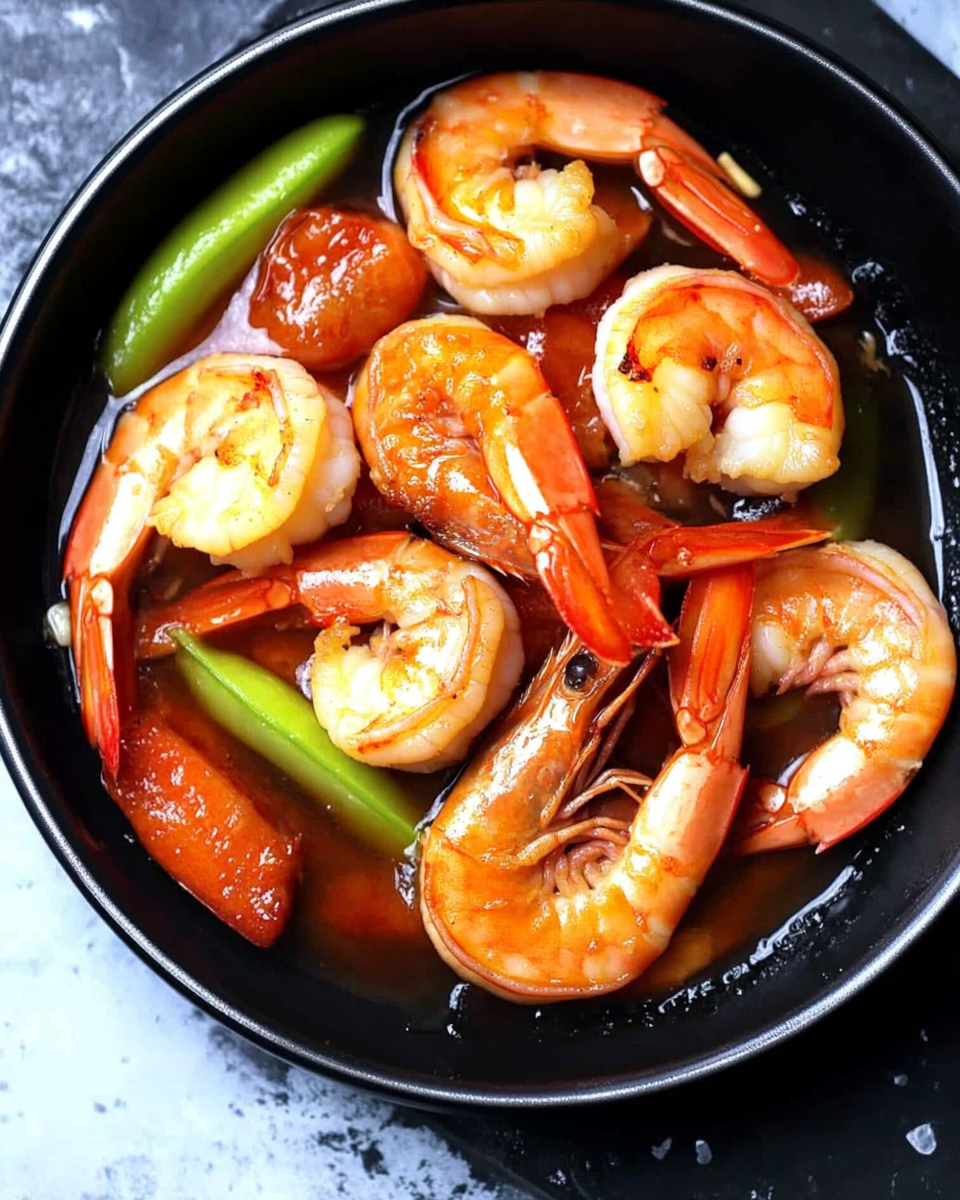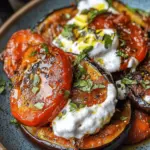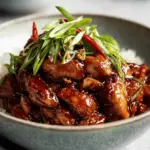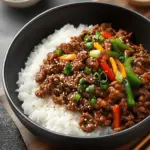Hunan Shrimp is a vibrant and fiery dish rooted in the culinary traditions of China’s Hunan province. Known for its bold flavors and spicy heat, this dish combines succulent shrimp with a medley of fresh vegetables, all tossed in a savory and spicy sauce. The hallmark of Hunan cuisine is its use of fresh chili peppers, garlic, and aromatic spices, creating a dish that is both flavorful and invigorating. Perfect for those who appreciate a bit of heat in their meals, Hunan Shrimp is a delightful representation of the dynamic flavors found in Chinese cooking.
Full Recipe:
Ingredients
- 1 lb large shrimp, peeled and deveined
- Salt and pepper, to taste
- 2 tablespoons cornstarch
- 2 tablespoons vegetable oil, divided
- 1 cup green beans, trimmed and cut into 1-inch pieces
- 1 cup bell peppers, diced (use a mix of colors)
- 4 cloves garlic, minced
- 1 tablespoon fresh ginger, minced
- 4 green onions, cut into 1-inch pieces (separate white and green parts)
For the Hunan Sauce:
- 2 tablespoons chili paste (e.g., Sambal Oelek)
- 1 tablespoon oyster sauce
- 1 tablespoon soy sauce
- 1 tablespoon rice vinegar
- 1 tablespoon ketchup
- 1 teaspoon sugar
- ¼ cup water
Directions
- Marinate the shrimp by seasoning with salt and pepper. Add cornstarch and toss to coat evenly. Set aside.
- In a bowl, combine chili paste, oyster sauce, soy sauce, rice vinegar, ketchup, sugar, and water. Mix well and set aside.
- Heat 1 tablespoon of vegetable oil in a wok or large skillet over medium-high heat. Add shrimp and cook for 2-3 minutes until pink and curled. Remove shrimp from pan and set aside.
- In the same pan, add the remaining 1 tablespoon of oil. Stir-fry green beans for 2 minutes. Add bell peppers, white parts of green onions, garlic, and ginger. Stir-fry 3-4 minutes until vegetables are tender-crisp.
- Return shrimp to the pan. Pour in the prepared Hunan sauce and stir to combine. Cook 2-3 minutes until sauce thickens and coats the ingredients well.
- Garnish with the green parts of green onions before serving.
Nutritional Facts (Per Serving)
- Calories: Approximately 280 kcal
- Protein: 30 g
- Total Fat: 14 g
- Saturated Fat: 2 g
- Cholesterol: 190 mg
- Sodium: 900 mg
- Total Carbohydrates: 8 g
- Dietary Fiber: 2 g
- Sugars: 3 g
- Vitamin A: 30% DV
- Vitamin C: 50% DV
- Calcium: 6% DV
- Iron: 15% DV
Cultural Significance and Culinary Background
Hunan province, located in south-central China, is famous for its cuisine that favors spicy and bold flavors, often with an emphasis on chili peppers and garlic. Unlike its neighbor Sichuan cuisine, which also uses chili but combines it with the numbing sensation of Sichuan peppercorns, Hunan cuisine is characterized by a straightforward, fiery heat that invigorates the palate.
Hunan Shrimp reflects the province’s agricultural richness, where fresh produce and seafood are abundant. The use of shrimp in this dish not only highlights the coastal influences but also showcases how simple, fresh ingredients can be transformed into complex, exciting flavors through thoughtful cooking techniques and seasoning.
In traditional Chinese culture, meals are often shared communally, and dishes like Hunan Shrimp are served family-style, allowing diners to enjoy a variety of tastes and textures together. The vibrant colors and bold flavors stimulate the senses and foster an atmosphere of warmth and conviviality at the dining table.
Flavor Profile and Ingredients Interaction
The hallmark of Hunan Shrimp is its bold and fiery flavor profile. The heat comes primarily from chili paste or fresh chili peppers, which deliver a sharp, immediate spice that awakens the taste buds. Garlic and ginger provide pungency and warmth, adding layers of aroma and complexity. The inclusion of soy sauce, oyster sauce, and rice vinegar balances the heat with umami, saltiness, and a hint of tang, respectively.
This interplay of flavors is enhanced by the freshness of the shrimp and vegetables. Shrimp brings a naturally sweet, tender texture that contrasts perfectly with the crispness of green beans and bell peppers. The green onions contribute a mild onion flavor and a fresh finish. The cornstarch coating on the shrimp helps create a slightly crispy exterior when cooked, providing a satisfying texture against the tender inside.
The sauce is integral to the dish, binding all the ingredients together with a glossy, savory coating that clings to every bite. This balance of spicy, sour, salty, and sweet notes embodies the essence of Hunan cuisine, making the dish vibrant and deeply satisfying.
Health Benefits of Hunan Shrimp
Hunan Shrimp is not just a treat for the palate but also a nutritious choice for those seeking healthy meals. Shrimp is an excellent source of high-quality protein, which is essential for muscle building and repair. It is low in calories and fat, making it an ideal option for weight-conscious eaters. Moreover, shrimp is rich in important nutrients such as selenium, vitamin B12, and omega-3 fatty acids, which support heart health, brain function, and immune defense.
The vegetables in the dish, like green beans and bell peppers, add dietary fiber, vitamins A and C, and antioxidants, which promote overall wellness and help fight inflammation. Garlic and ginger, common in Hunan cooking, are known for their anti-inflammatory and immune-boosting properties, adding another layer of health benefits.
By grilling or stir-frying the shrimp and vegetables quickly, the recipe preserves nutrients while using minimal oil, which keeps the dish light and healthy. This cooking method also enhances the natural flavors and textures without unnecessary heaviness or greasiness.
Culinary Techniques and Preparation Insights
The preparation of Hunan Shrimp involves techniques that highlight the freshness of ingredients and the harmony of flavors. Marinating the shrimp briefly with cornstarch helps to achieve a light coating that crisps up during cooking, adding texture without heaviness. Stir-frying over high heat cooks the shrimp and vegetables quickly, locking in moisture and preserving the vibrant colors and crunchiness.
Balancing the timing is crucial; overcooking shrimp can result in a rubbery texture, while undercooked shrimp is unsafe to eat. The vegetables should be cooked just enough to retain their crunch and freshness, providing a contrast to the tender shrimp.
The sauce is usually made from simple pantry staples but achieves complexity through the precise ratio and timing of addition. Adding the sauce towards the end of cooking allows it to thicken slightly, evenly coating the ingredients and intensifying the flavor.
Using fresh aromatics like garlic, ginger, and green onions contributes to the dish’s dynamic taste and fragrance, making the cooking process itself an aromatic and enjoyable experience.
Serving Suggestions and Pairings
Hunan Shrimp is a versatile dish that can be served in multiple ways to suit various meals and preferences. It is traditionally enjoyed as a main course accompanied by steamed white rice or fried rice, which helps mellow the heat and absorb the flavorful sauce.
For a lighter option, it can be served alongside a fresh cucumber salad or simple stir-fried greens. The freshness and crunch of these sides complement the bold and spicy shrimp, creating a balanced meal.
This dish also pairs well with classic Chinese staples like dumplings, spring rolls, or hot and sour soup, making it ideal for a full multi-course dinner. Garnishing with fresh cilantro or extra green onions adds a bright finishing touch and enhances visual appeal.
For those who enjoy spicy food, serving Hunan Shrimp with a cold beverage like iced tea or a light beer can help balance the heat and refresh the palate.
Adaptations and Variations
One of the great strengths of Hunan Shrimp is its adaptability. While the classic recipe emphasizes shrimp and a specific chili-based sauce, it can easily be modified to suit different tastes and dietary needs.
For milder palates, the amount of chili paste can be reduced or replaced with a less spicy sauce. Those who prefer extra heat can add fresh sliced chilies or chili oil. The vegetable mix can also be varied according to availability and preference; zucchini, snap peas, or mushrooms work well as substitutes or additions.
For a gluten-free version, tamari can replace soy sauce, and alternative sweeteners can substitute sugar or ketchup. Vegetarians can swap shrimp for tofu or tempeh, adapting the marinade and cooking times accordingly.
Such flexibility allows Hunan Shrimp to be a crowd-pleaser that can be tailored for various occasions, from casual weeknight dinners to special gatherings.
Cultural Experience and Enjoyment
Eating Hunan Shrimp is more than just a meal—it’s an experience that connects you to the rich culinary heritage of China’s Hunan province. The vibrant colors, enticing aromas, and exciting heat awaken the senses and invite diners to savor the complex interplay of flavors.
In many Chinese households, sharing dishes like Hunan Shrimp fosters a sense of community and togetherness. The act of passing plates around, trying different flavors, and enjoying a lively meal together is central to the culture’s approach to food.
Introducing Hunan Shrimp into your cooking repertoire not only expands your palate but also offers a glimpse into a fascinating culinary tradition that values boldness, freshness, and balance.
Conclusion
Hunan Shrimp is a dish that embodies the spirit of Hunan cuisine—bold, fiery, and full of life. Its combination of tender shrimp, fresh vegetables, and a spicy, tangy sauce creates a satisfying and nutritious meal that appeals to many tastes.
The dish’s health benefits, vibrant flavors, and adaptability make it an excellent choice for home cooks and food enthusiasts alike. Whether you are new to Chinese cooking or an experienced lover of Asian flavors, Hunan Shrimp offers a delicious way to explore the rich culinary landscape of Hunan province.






